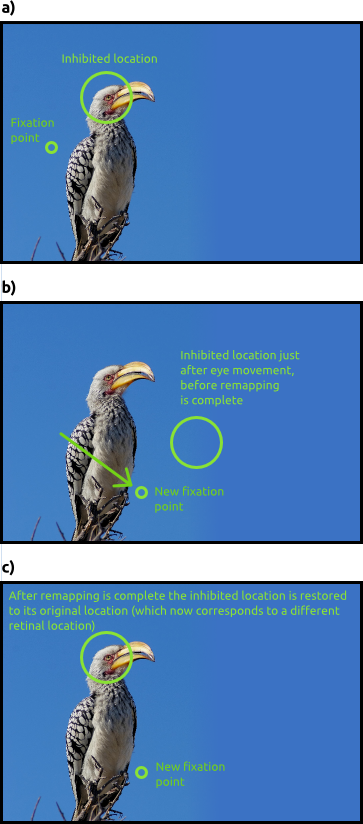Today I would like to highlight a study by Jan Theeuwes (my PhD supervisor) and myself, to celebrate that the paper is now officially available. (It's still in press, but Psychological Science provides “online first” access to articles. If you do not have access to Psychological Science, you can find an unofficial postprint here.)
In this paper we focus on the “problem” of eye movements. This may seem strange. Clearly, the ability to make eye movements is very adaptive, because it allows us to quickly scan the environment without having to make head (or body) movements, which are costly in terms of time as well as energy. So what's the problem?
 The “problem” that I'm referring to is that with every eye movement, the retinal image of the world changes enormously. Therefore, if we were to take changes in the retinal image as evidence for changes in the world around us, we would perceive a dizzyingly unstable world. Which, clearly, we don't. We may be vaguely aware of the fact that we make eye movements, but subjectively it does not feel as though eye movements interfere with our sense of “visual stability”. Apparently, the visual system somehow compensates very effectively for eye movements.
The “problem” that I'm referring to is that with every eye movement, the retinal image of the world changes enormously. Therefore, if we were to take changes in the retinal image as evidence for changes in the world around us, we would perceive a dizzyingly unstable world. Which, clearly, we don't. We may be vaguely aware of the fact that we make eye movements, but subjectively it does not feel as though eye movements interfere with our sense of “visual stability”. Apparently, the visual system somehow compensates very effectively for eye movements.
Another phenomenon on which we focus in the paper is “inhibition of return” (IOR). IOR refers to the fact that after we have attended to some location, either covertly (i.e., from the corner of our eye) or by looking at that location, we ignore that location for a few seconds afterwards. This is a useful mechanism, because it prevents us from looking at (or covertly attending to) the same locations over and over again, while ignoring the rest of the visual field. Simply put, we temporarily “tag” locations that we have seen/ attended to: Been there, don't look at it again!
Many researchers (and I'm one of them) believe that the visual system stores positional information largely based on where an object falls on the retina, and not based on where the object really is. This is equally true for IOR. We do not tag an object per se, but we tag a location on the retina. After an eye movement, this same retinal location corresponds to a different location in the outside world (see (b) in the figure). Therefore, after an eye movement we are inhibiting a completely different location in the outside world, which is obviously not what we want. The visual system appears to deal with this problem by essentially picking up the retinotopic inhibitory tag and putting it back at a new retinotopic location, which now (after the eye movement) corresponds to the proper location in the outside world (see (c) in the figure). This process of compensating for retinal displacements is called “remapping”.
We also investigated the time course of remapping in the context of IOR. We found that, just after an eye movement (0ms to 100ms, say), it appears as though the inhibitory tag has “moved with the eyes” (b). Presumably, this is because at this point remapping is not yet complete: The visual system is still compensating for the eye movement that has just been executed. At longer intervals after the eye movement this weird “retinotopic IOR” is gone, and it's as though the eyes have never moved (c)!
Photo from Wikimedia Commons
References
Mathôt, S., & Theeuwes, J. (in press). Gradual remapping results in early retinotopic and late spatiotopic inhibition of return. Psychological Science. [PDF: Official] [PDF: Author generated postprint]
Mathôt, S., & Theeuwes, J. (in press). Visual attention and stability. Philosophical Transactions of the Royal Society B: Biological Sciences. [PDF: Author generated postprint]



